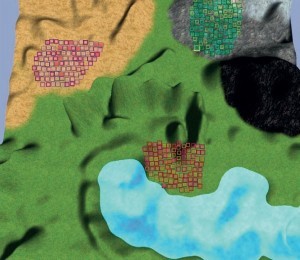Information as a Sedative
A study by Professor Eldad Yechiam of the Technion reveals that counter to intuition; information about key dangers actually creates indifference towards them.

Simulation of the experimental environment – “microworld”. In each round, the participants can choose one of the three areas (villages).
Intuitively, it seems that the more information there is about risks, the more careful we are. If we have to choose between a city where life is dangerous and a city where life is safe, we will choose the latter. This intuition is refuted in a new study published in the journal “Nature Climate Change”. The study, conducted by Professor Eldad Yechiam from the Faculty of Industrial Engineering and Management at the Technion together with colleagues from England and Australia, reveals that the more information about the danger there is, the more the “appetite for risk” actually prevails. In other words, intense coverage of unusual adverse events may actually bring about a calming effect.
The aforementioned study focused on severe climatic events such as fires, floods and tsunamis. The research question was whether daily information on such events reinforces – or actually weakens – the urge to get away from those places. The test was conducted using a simulation of a “microworld” – a reality in which the participant had to decide which village (out of three) he wanted to live in. Two of the villages were characterized by a better quality of life than the third, but also by a higher probability of earthquakes. The simulation was held in several rounds, in each of these round each participant was given the option to change his decision.
Each participant was exposed to different levels of daily information about the earthquakes in the region – from minimal information about what was happening in his home alone to a “full media report” of what was happening in all the homes. The findings were surprising: the more extensive the information, the greater the participant’s tendency to choose the villages that are more prone to earthquakes.
According to Professor Yechiam, the explanation is simple. “Whenever there’s a rare natural event such as an earthquake, detailed information only emphasizes its rarity, and the person who has to make a decision will choose the dangerous village because it’s a better place in normal times. The good daily routine is perceived as an advantage that outweighs the rare risk, and therefore the person will prefer a good and slightly dangerous life to a safe but not so good life. He knows that if he chooses the safe and bad life he’ll feel like a sucker – because most of the time the detailed information will emphasize the disadvantages of his choice.
This same kind of pattern was found following one of the U.S most famous earthquakes, the Loma-Parieta earthquake that hit Northern California in 1989. The earthquake, widely covered by the media, resulted in homeowners reducing the risk estimate of their home insurance. This might have been because of homeowners’ notion that “earthquakes do not strike in pairs” (which is geographically wrong), or because of media attention. The new study suggests that media attention alone increases appetite for risk in situations of rare hazards. In Professor Yechiam’s estimation, a similar dynamic may appear with reports about Terrorist attacks. “When I am exposed to full and detailed information from the media, and receive information about a terrorist attack in any given city, I conclude that the situation is calm everywhere else. Moreover, within a short time the event in that city will also become a rare event and I will no longer avoid visiting there.”



